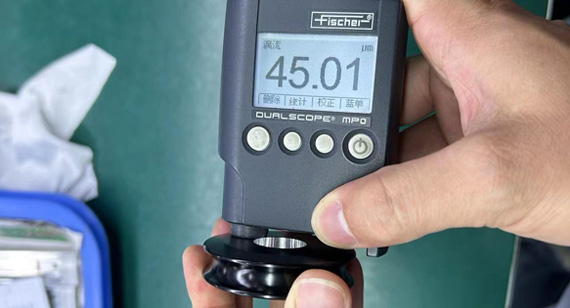15 years one-stop China custom CNC machining parts factory

Hey there I’m VMT Sam!
With 25 years of CNC machining experience we are committed to helping clients overcome 10000 complex part-processing challenges all to contribute to a better life through intelligent manufacturing. Contact us now
 127 |
Published by VMT at Feb 14 2024
127 |
Published by VMT at Feb 14 2024
Detecting Coating Thickness on Aluminum CNC Machined Parts: Methods and Techniques
In the manufacturing process of CNC machined parts, coating treatment is a crucial step in enhancing part performance. The coating thickness on the surface of aluminum CNC machined parts directly impacts the appearance, corrosion resistance, and functionality of the parts. Therefore, accurate detection of coating thickness is vital to ensure product quality and performance. This article discusses how to detect the coating thickness on the surface of aluminum CNC machined parts to ensure the reliability of product quality and performance.

I. Importance of Coating Thickness Detection
The uniformity and consistency of coating thickness are crucial for the performance of aluminum CNC machined parts. Too thin coatings may reduce corrosion resistance, while excessively thick coatings can affect the appearance or functionality of the parts. Therefore, accurate detection of coating thickness is a key step in ensuring the performance and reliability of parts.

II. Coating Thickness Detection Methods
Mechanical Measurement Method:
Mechanical measurement is the most traditional method for coating thickness detection. It involves using mechanical measurement tools such as calipers or thickness gauges to directly contact and measure the thickness of the coating. This method is straightforward and has relatively low requirements for detection equipment and skills. However, it may not be suitable for some special coatings or complex-shaped parts.
Radiation Measurement Method:
The radiation measurement method utilizes the absorption and transmission characteristics of different materials to measure coating thickness. Common radiation sources include X-rays and beta rays. This method allows non-contact measurement and is suitable for detecting coating thickness on various shapes and materials. However, the radiation measurement method requires specialized equipment and operational skills, and there may be radiation safety concerns.
Eddy Current Measurement Method:
The eddy current measurement method utilizes the principles of eddy currents to calculate coating thickness by measuring the changes in eddy currents passing through the coating. The advantages of this method include non-contact measurement, speed, and applicability to coatings with no special requirements for conductivity. However, this method may be less accurate for multi-layer coatings or coatings containing conductive materials.
Optical Measurement Method:
The optical measurement method utilizes the interference, diffraction, or scattering principles of light to measure coating thickness. Common optical measurement instruments include spectrometers, ellipsometers, and reflectance spectrometers. The advantages of optical measurement include non-contact, non-destructive measurement applicable to various coating materials. However, this method requires specialized optical equipment and skills and may be influenced by ambient light.
III. Choosing the Appropriate Detection Method
When selecting a coating thickness detection method, factors such as specific application scenarios, equipment accuracy requirements, operational skills, and costs should be comprehensively considered. For simple and routine detection needs, the mechanical measurement method may be the most suitable choice. For special coatings or complex-shaped parts, the radiation measurement method, eddy current measurement method, or optical measurement method may be more applicable. When choosing any detection method, ensure its accuracy and reliability, taking into account its potential impact on the environment and operators.
IV. Conclusion
Detecting the coating thickness on the surface of aluminum CNC machined parts is a critical step in ensuring product quality and performance. This article introduced four commonly used coating thickness detection methods: mechanical measurement, radiation measurement, eddy current measurement, and optical measurement. In practical applications, the choice of an appropriate detection method should be based on specific requirements to ensure accuracy and reliability. With ongoing technological advancements, there may be more efficient and precise coating thickness detection methods in the future, further enhancing the performance and reliability of aluminum CNC machined parts.
Ready To Start Your Next Project?
Get Instant Quote

Request a Free Quote
Send us a message if you have any questions or request a quote. We will get back to you ASAP!